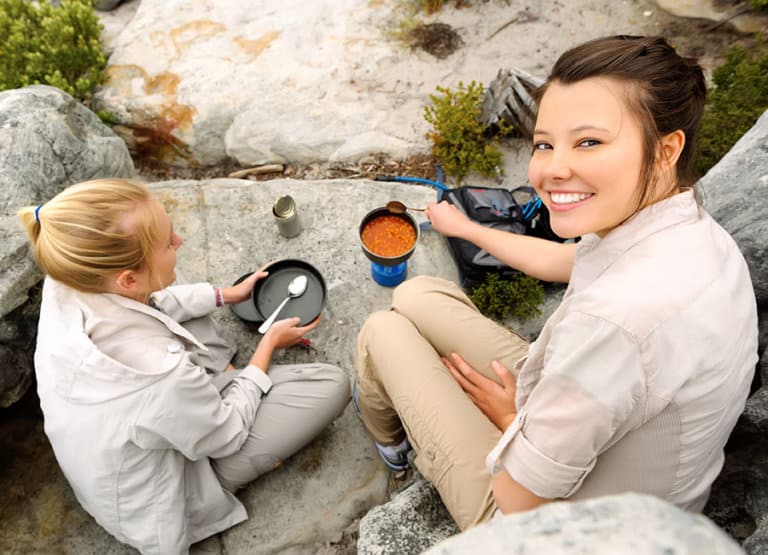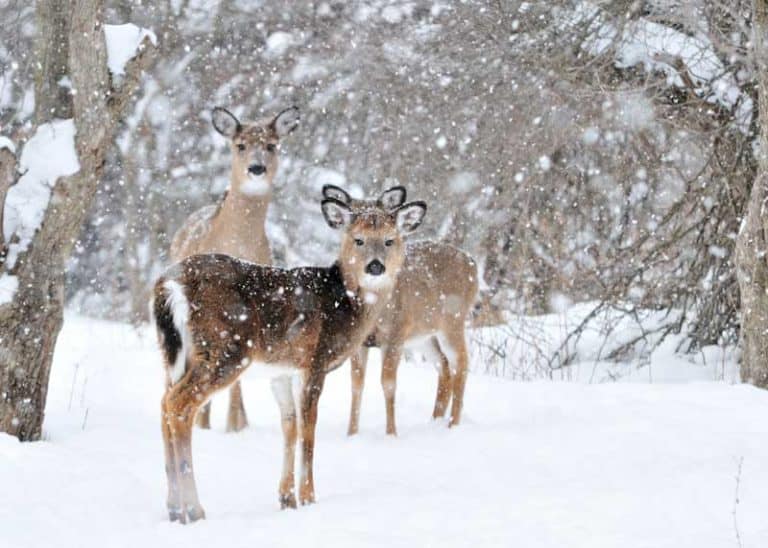19 Winter Hiking Tips: Keeping You Warm, Safe, and Happy
Heading out on a winter hike? Nice! In this post, you’ll find a great set of winter hiking tips to keep you warm, safe, and happy. Let’s do this!

Enjoy camping? Check out our huge set of winter camping tips.
19 Winter Hiking Tips: Stay Warm, Safe and Happy
Hiking in winter can be amazing. Things open up as the trees lose their leaves making wildlife and birdlife more visible. And the piercing blue clear skies are something to behold.
We’ve put together this list of 19 great tips (with gear recommendations) to help you get out there on the trails and enjoy your time outdoors.

1. Be an onion
Just like an onion you need layers. Dressing in layers makes it easy for you to regulate your body temperature during the hike, especially if it is an all-day hike.
There may be a big temperature difference when you start your hike early in the day down in a valley to when you reach a ridgeline or mountain peak in the middle of the day, so be an onion and just add or remove layers as needed.
Four Recommended Layers for Winter Hiking
- Moisture-wicking / tight layer
- Fleece
- Insulated layer / Down filled
- Waterproof layer
2. Weather check
Keep an eye on the weather in the area you are going to hike in for a couple of days before you set out.
If there is a blizzard coming you don’t want to get caught out in that! A glance at a weather app can be a lifesaver.

Thinking about a hammock? Check out these winter hammock camping tips.
3. Know the area
Do some research and look online at the area you will be hiking through. Are there any hidden dangers that may be harder to see covered in snow like small ravines etc.?
Of course, staying on the path is always the wisest choice but for some reason, if you need to stray from the path little things like this make all the difference to your confidence and ensuring you have a safe and fun hike.
4. Freshen up on your compass skills
Alongside your GPS or phone tracker, take a map and compass and have some fun. Just like in the olden days, look at your map, plan your route and see which is the best and safest way to get there.
Just like a pirate coming ashore, place an X on where you want to go before you set out on your adventure and have fun exploring as you go. Kids love it too… especially the big kids.
5. Extra socks
Something you don’t usually think of but plays a huge part in the enjoyment of your hike.
If your feet are cold and wet, not only will you have blisters the size of cantaloupes but you are going to be miserable squishing around in your boots.
If in a snowy area, it will also help increase the chances of returning with fewer toes than you started out with – so if your feet get wet, changing your socks makes a huge difference.
6. Lip balm
Yes, it sounds weird but not only will it protect your lips it will also protect your pack.
If your pack is dry or squeaks at some point, then by rubbing a little lip balm on it you could help reduce friction (leading to a possible hole/tear) and you won’t get driven crazier with every step you take by having to listen to squeak, squeak, squeak.
7. Sip water often
Being winter, it’s cold and you may not feel that thirsty, but it is important to stay hydrated.
Your body still needs to replace what you are losing even if you don’t realize it.
8. Learn basic first aid
This goes for any time of year. Learning First Aid is an important and necessary life skill for anyone regularly spending time outdoors.
In winter, things can quickly become more serious if something does go wrong. First Aid helps you gain the confidence that if something goes wrong you can handle it.
9. Lists, Lists, Lists
A list for gear, a list for food and beverages, and if you’re a birder don’t forget your lifer list. With all of those bare winter trees, you may just spot that lifer you have been dying to see.
If you have a checklist, then it’s all smooth sailing and you will not be the one looking silly because what you need is actually at home sitting on the table where you left it – so “you wouldn’t forget it”. But don’t be too hard on yourself, we’ve all done that.
10. Good boots are a MUST
Especially for those just starting out, comfortable supportive boots are the difference between swollen blistered feet and being miserable for the next few days.
Or returning home happy with a healthy glow in your cheeks, excited, relaxed, and ready to plan your next hike.
11. Cuppa Joe, Java, Choco Malto Latte
Taking a small lightweight portable stove like a Jetboil has a multitude of benefits. It not only adds some comfort to your hike but also helps keep you hydrated.
Stopping for a morning tea, coffee or hot chocolate also has the added perk of allowing your body to disperse some of that metabolic waste your legs build up during hiking so you aren’t as sore the next day.
Plus, it’s a good time to record your journey and get some happy snaps or peacefully watch for wildlife.
12. Waterproof shell and wet weather gear
Lightweight and easily stowed in an outer pocket of your pack, having a rain jacket helps keep you dry and warm both as waterproofing and as protection against the icy cold wind shear.
As you climb higher on your hike, cold winter winds can feel like they are slicing through you – you’ll LOVE your jacket.
Handy Hint: If it does start to rain, take a small towel or strip of material and fold it lengthways into a strip. Place this around your neck as you put on your rain hood as added protection. If any water does get in this will help keep you dry and reduce your chill factor. Especially handy if you end up getting stuck overnight.
13. Bring snacks … beware of rogue squirrels
Spicy trail mixes, dried fruit, granola bars or anything else your heart desires.
Whenever setting out on a walk it is a good idea to have some delicious long-lasting snacks that will provide energy on your walk.
That way if you take longer than expected, you always have some emergency rations to keep you going.
14. Hand warming packets
Nifty bits of kit to have with you for winter hiking, heat pads or hand warmers can be an absolute lifesaver especially if you are camping overnight.
The good news is that when placed in your sleeping bag or pocket, they just keep getting warmer ensuring you sleep like a baby with toasty warm toes.
Plus, they weigh next to nothing so you won’t even realize it’s there, slipping one into your pack can make the difference between you having a great hike or feeling like your fingers might snap off.
15. Sun protection and good sunglasses
Yes, it’s winter, and yes it’s cold, but you can still get quite sunburnt before you realize it.
Dermatone Stick (SPF23) protects against sun damage – and chapping from cold and wind. This is for nose, ears, face, lips, and forehead.
The sun reflects well off of snow so not only does it double your chances of getting sunburned it can also be blinding – making a good set of wraparound sunglasses a must if you want to see where you are going clearly without hours of squinty face.
16. Waterproof everything
Don’t put a dampener on your hike, waterproof your boots, your pack, your jacket and your tent (if going for a long hike and camping).
Keeping you dry, especially during winter when everything takes so long to dry if it does get wet, is the only way you will stay warm and comfortable.
A lot of experienced hikers will double waterproof their boots because things tend to get a little squishier during winter and having cold wet feet is the worst.
17. Pack for access
Easy access to things you will need makes your life easier and your hiking experience so much better and stress-free.
If you have to dismantle your pack looking for something, then not only do you get frustrated but so does the rest of your hiking party. Most hiking packs have lots of outside pockets and loops you can hang things off of for easy access.
18. Don’t forget your camera
Hiking provides a lot of amazing photo opportunities. Sweeping scenery, clear skies, forestry, and lakes. The whole reason we enjoy hiking so much is to experience these glorious panoramas so be sure to capture them with some amazing shots.
An action camera is a great choice for hiking, especially in the winter. It is waterproof and lightweight. Learn more in our GoPro Hiking Photography Guide.
Plus, you could also upload your shots when you get home and sell them as stock! Imagine how much that guy who took the photo of the cliff face that Apple uses as a backdrop on their Macs made from that one shot!
19. Clean Drinking Water
Having an alternative way to create clean, safe drinking water is one thing that every hiker needs in their kit whether they are hiking for a day or a week.
Something lightweight, durable, and reliable like a LifeStraw is an essential item for every outdoor adventure, and removing 99.999% of bacteria and parasites means you never get caught without water.


Check out our full Guide to Winter Camping
Your Turn
What are your hiking plans this winter? Let me know in the comments!






